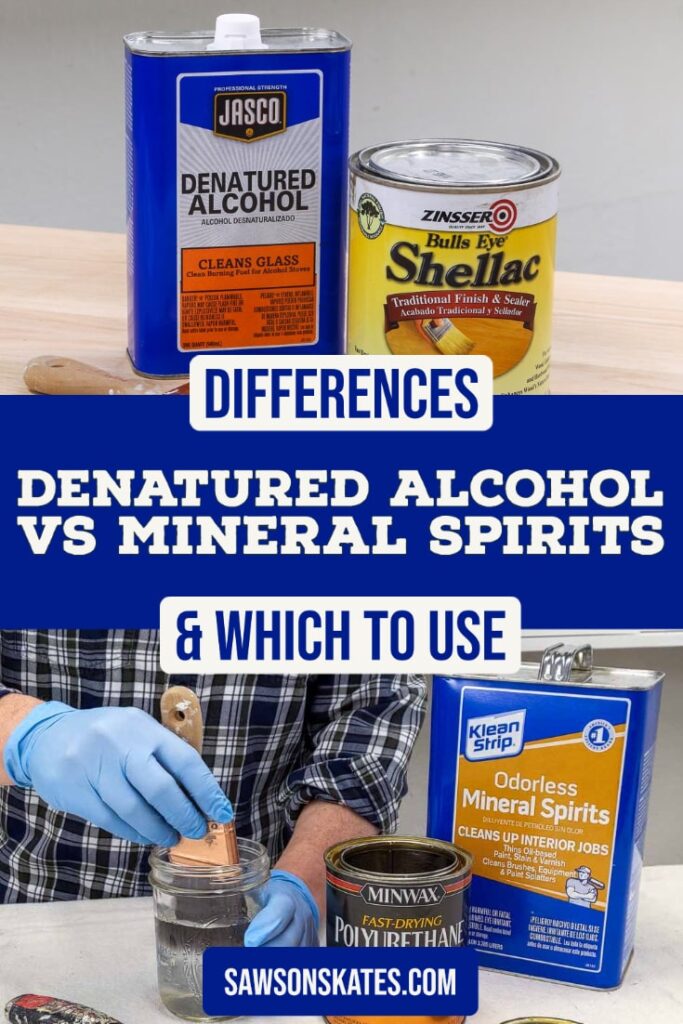Denatured Alcohol vs Mineral Spirits (Differences + Uses)
Denatured alcohol and mineral spirits are both solvents, but what are the differences between them? I’ll break it down in this side-by-side comparison.
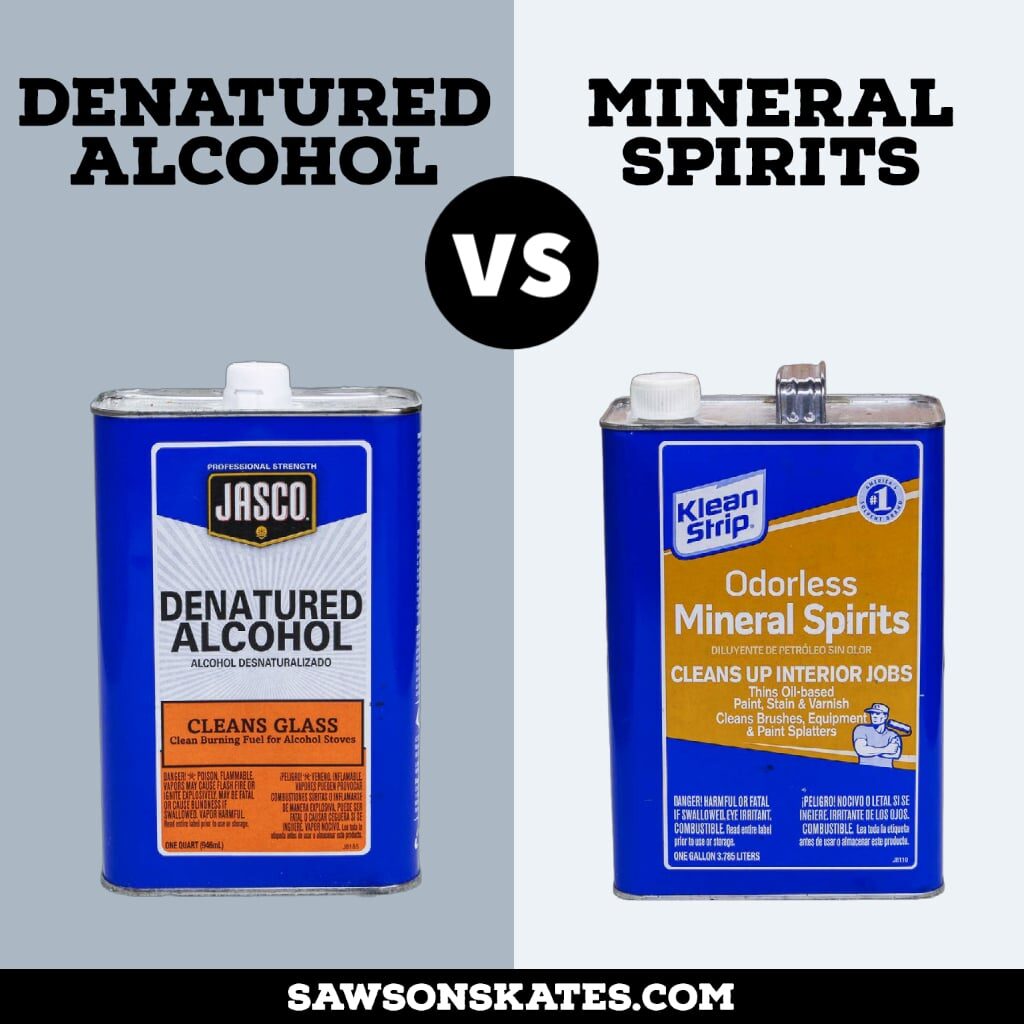
You’ve probably heard of denatured alcohol and mineral spirits, but if you’re like most people, you’re unsure of their differences. In this article, I’ll explain what they are, how they’re used, the benefits and drawbacks of each, and which one to use for your project. Let’s get started!
This tutorial contains affiliate links to supplies and tools. Purchases made using these links help support the Saws on Skates website and allows me to share more projects and tips with you. There is no cost to you for using these links. Visit my site policies for more information.
Table of Contents
- What is Denatured Alcohol?
- What is Denatured Alcohol Used For?
- What Can You Substitute for Denatured Alcohol?
- Pros and Cons of Denatured Alcohol
- What is Mineral Spirits?
- What is Mineral Spirits Used For?
- What Can You Substitute for Mineral Spirits?
- Pros and Cons of Mineral Spirits
- What’s the Difference Between Denatured Alcohol and Mineral Spirits?
- Denatured Alcohol and Mineral Spirits Safety
- Which One Should You Choose?
- Comparison Chart
- Frequently Asked Questions
What is Denatured Alcohol?
Denatured alcohol is a water-soluble solvent made from ethanol. Ethanol is a type of alcohol made from plants and is the main ingredient in beverages like beer, wine, and liquor.
In contrast to other types of alcohol, this one has been denatured, which means it has been changed chemically or physically. In the case of denatured alcohol, chemicals are added, making it toxic to drink.
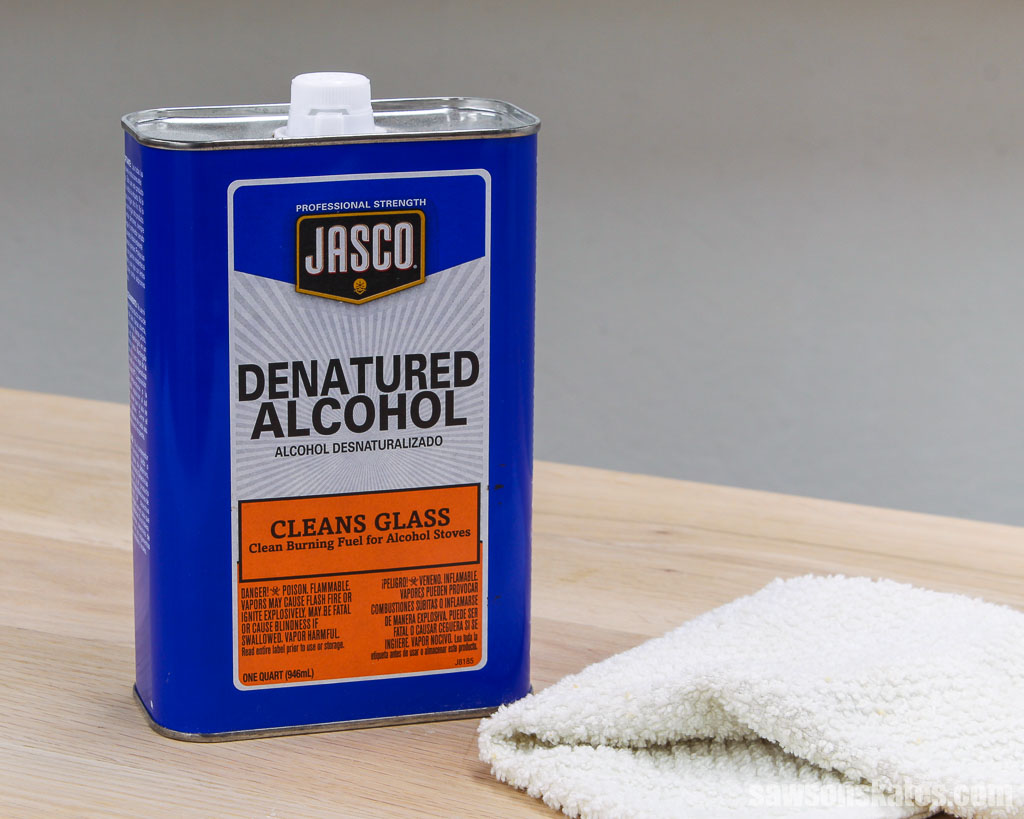
The alcohol is denatured for tax reasons. According to this article by Culinary Solvent, “Food grade non-denatured ethanol is regulated and taxed by Tax and Trade Bureau, a Department of the Internal Revenue Service.” The article goes on to say, “Denatured and non-denatured ethanol are taxed at different rates.”
Because food-grade alcohol is taxed higher than nonhuman-consumption alcohol, denaturing it lowers the tax burden.
Although denatured alcohol is a clear-colored liquid, it may be dyed purple or blue as a requirement for tax purposes.
Denatured alcohol evaporates quickly, usually within a few minutes. Because it’s flammable, keep denatured alcohol away from heat sources and open flames. It also has strong, harmful fumes that can cause headaches or worse, so be sure to work in a well-ventilated place.
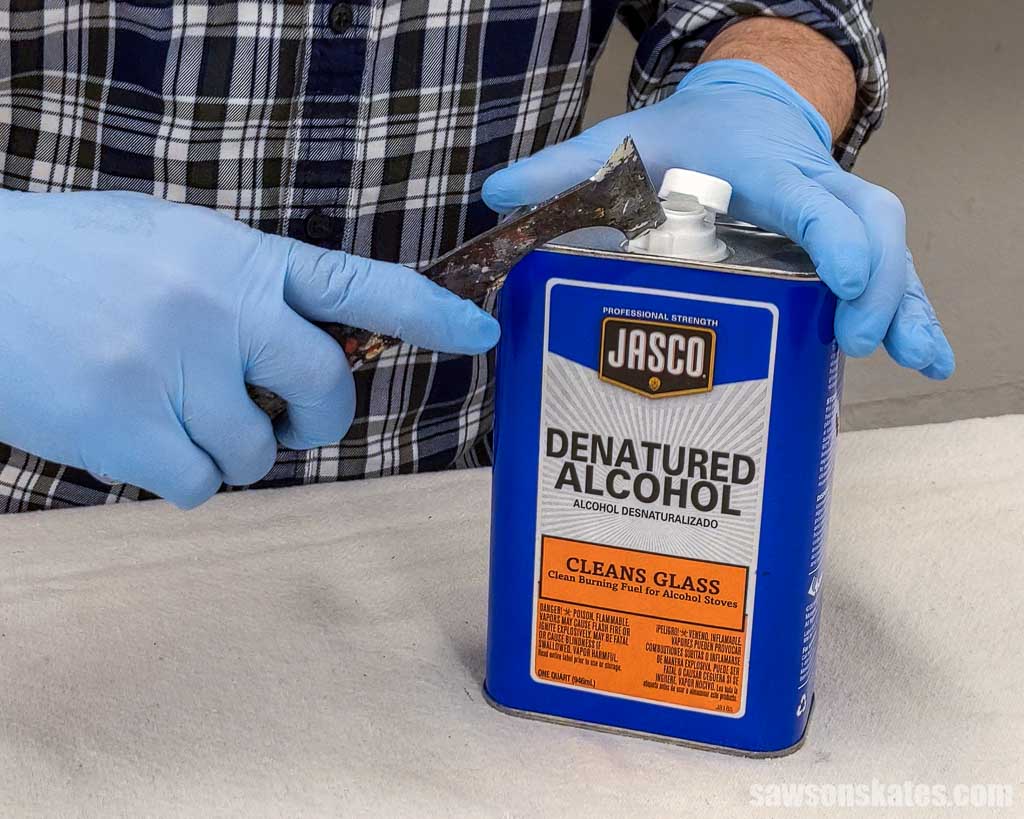
What is Denatured Alcohol Used For?
Denatured alcohol may be used for a variety of purposes, but whatever you do, wear disposable gloves because it’s harsh and can cause dryness, severe irritation, or stinging or burning on your skin.
💡 TIP: Remember always to test it on an inconspicuous area to ensure it doesn’t damage the surface.
Solvent
Denatured alcohol is frequently used as a solvent to dissolve shellac flakes for making shellac wood finish, and it can also be used to clean brushes soaked in shellac.
Related: What You Need to Know About a Shellac Wood Finish
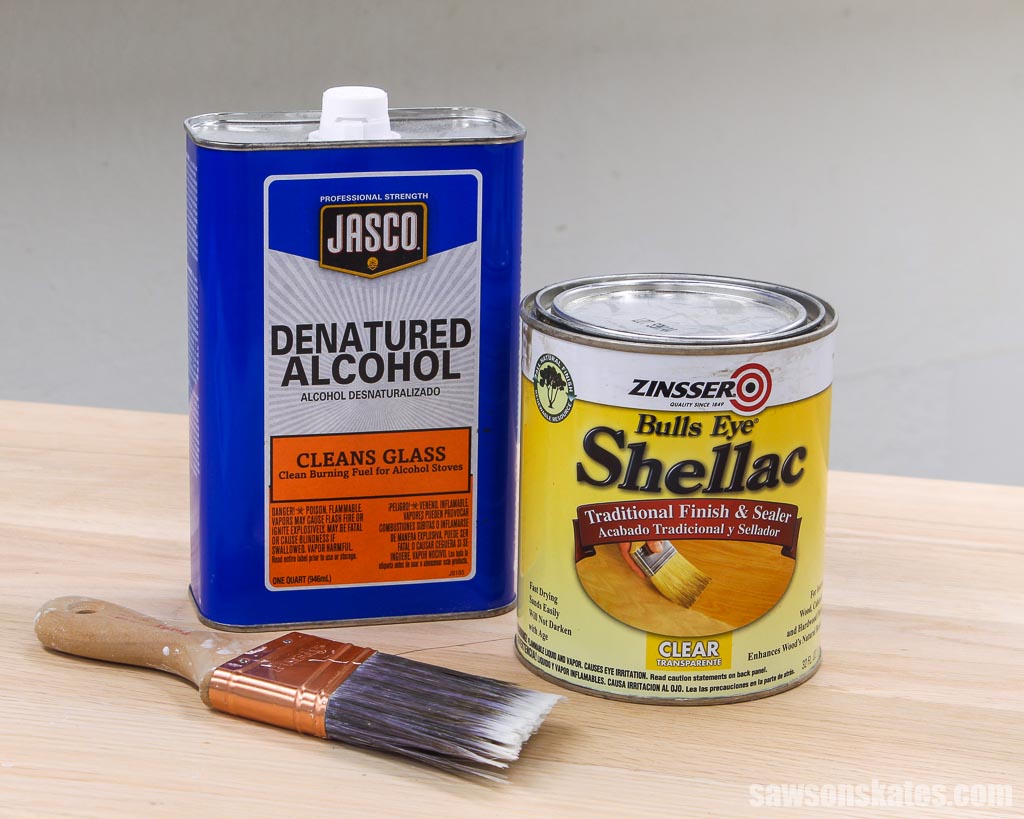
Glass Cleaner
It’s excellent for cleaning glass, windows, and mirrors because it dries quickly and doesn’t leave streaks.
Fuel
Denatured alcohol is flammable and used as a fuel for portable camping stoves and lamps.
All-Purpose Cleaner
You can use it to clean and disinfect surfaces like kitchens, bathrooms, countertops, doorknobs, etc. It can also be used to clean metal surfaces like brass, copper, and stainless steel.
📝 NOTE: Denatured alcohol will dissolve a cured shellac wood finish, so be careful using it on wooden surfaces if you’re unsure what kind of top coat was used to protect the wood.
Ink Stains
It may be used to get ink stains out of fabrics such as clothing or upholstery.
Mildew and Mold
It can also be used to eliminate mildew and mold from surfaces.
Remove Adhesives
Need to remove sticky tape from a surface or labels from glass jars? Denatured alcohol will do the trick!
What Can You Substitute for Denatured Alcohol?
If you don’t have denatured alcohol on hand, you can use a few other options as substitutes.
Denatured alcohol is derived from ethanol, so just about any type of ethanol-based alcohol will work as a stand-in, including methanol and isopropyl alcohol (rubbing alcohol).
Depending on what you want to do with it, some food-grade alcohols may work. For example, beer and wine will dissolve a shellac finish, so furniture such as dining tables are not usually sealed with shellac.
Pros and Cons of Denatured Alcohol
Pros
- It’s a relatively inexpensive and effective solvent.
- It evaporates quickly without leaving streaks or residue.
- It can be used for cleaning and sanitizing a variety of surfaces.
- It can be used as a fuel for portable camping stoves and lamps.
Cons
- It’s harsh and can cause skin irritation.
- It’s flammable, so use it with caution.
- It has strong fumes that can cause headaches, eye and respiratory tract irritation, and more.
- If ingested, it can be toxic.
What is Mineral Spirits?
Mineral spirits is a solvent made from petroleum, a type of fossil fuel found underground. It’s refined to create gasoline, kerosene, and other products such as mineral spirits.
Mineral spirits is also called white spirit, mineral turpentine, and artist’s white spirit. It’s often used as an ingredient in some paints and finishes like oil-based polyurethane.
Related: Polycrylic vs Polyurethane: Are They The Same?
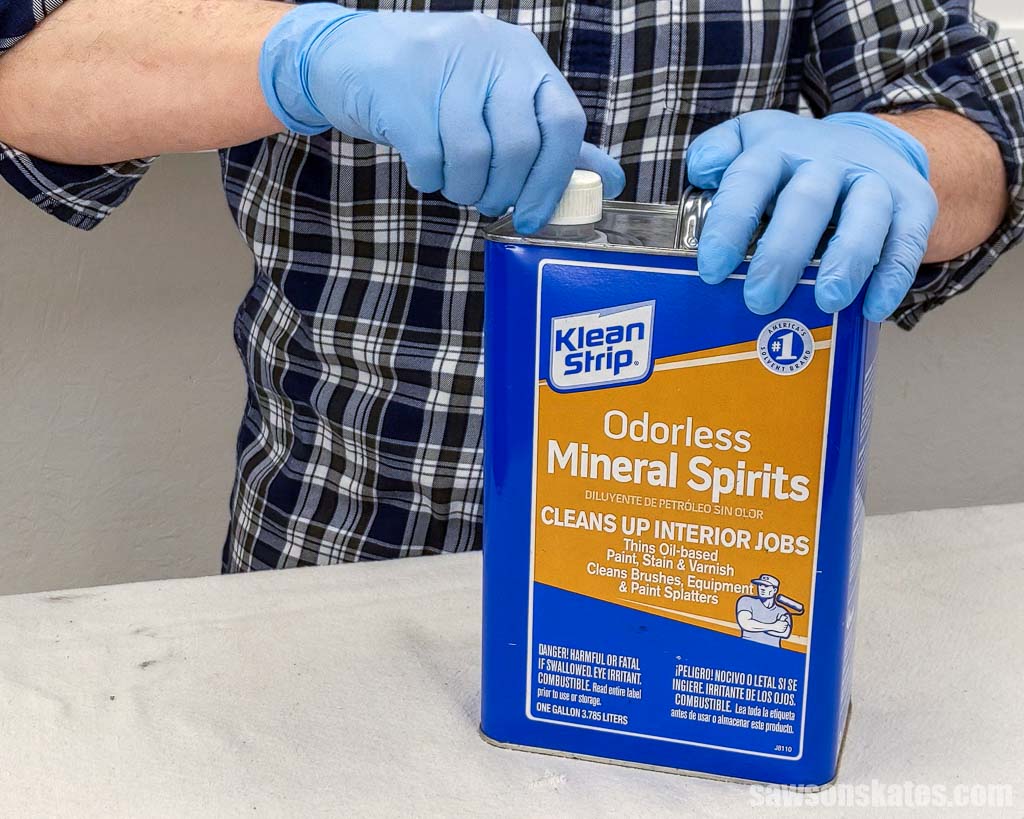
Mineral spirits is flammable, so keep it away from heat sources and open flames. It also has strong, hazardous vapors that can cause headaches and irritation, so work in a well-ventilated area.
Odorless mineral spirits are available, which are refined even further to eliminate the strong fumes.
Unlike denatured alcohol, mineral spirits is not water-soluble.
What is Mineral Spirits Used For?
Mineral spirits can be used for various applications; however, use rubber gloves because it is harsh and can cause dryness, severe irritation, or stinging or burning on the skin.
💡 TIP: Remember always to test it on an inconspicuous area to ensure it doesn’t damage the surface.
Thinning Oil-Based Paints, Stains, and Varnishes
Mineral spirits can be used to thin oil-based paints, stains, and finishes. Thinning means reducing the consistency of the paint so it can be spread more easily and evenly.
Some people refer to mineral spirits as paint thinner, but paint thinner is a specific type of mineral spirits that is less refined.
Cleaning Paint Brushes and Other Painting Equipment
After you’re done with your oil-based paints, stains, and finishes, mineral spirits can be used to clean paint brushes and other painting equipment.
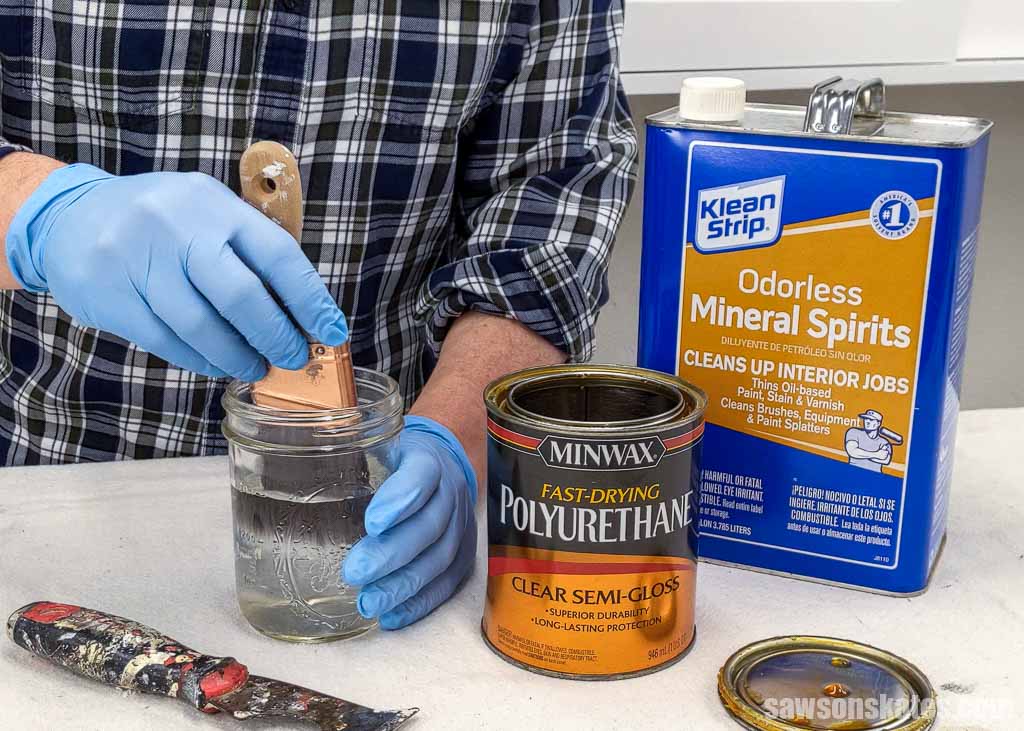
Cleaning Wood Surfaces
Mineral spirits won’t dissolve cured finishes such as polyurethane, lacquer, varnish, and shellac, so it can be used to clean wooden surfaces like furniture and floors. But to be on the safe side, always test it on an inconspicuous area first.
⚠️ IMPORTANT: Do not use it on wood with a wax finish.
Degreasing Metal Surfaces
Mineral spirits breaks down petroleum-based oil and grease, so it can be used to clean metal parts and machinery.
Removes Adhesives and Pine Sap
You can use mineral spirits can also be used to remove adhesives such as the sticky residue from price tags. It may also be used to remove pine sap from surfaces.
What Can You Use as a Substitute for Mineral Spirits?
If you don’t have mineral spirits on hand, you can use a few other options as substitutes.
Turpentine or paint thinner can be used instead of mineral spirits to clean oil-based paint-soaked brushes and other painting equipment.
Denatured alcohol or acetone (nail polish remover) can be used instead of mineral spirits to remove sticky substances such as labels and price tags.
Related: Mineral Spirits vs Acetone (Differences + Which to Use)
Pros and Cons of Mineral Spirits
Pros
- It’s a strong solvent that can be used for thinning and cleaning oil-based paints, stains, and finishes.
- It’s available in an odorless version.
- It removes sticky substances such as adhesives and pine sap.
Cons
- It’s flammable, so use it with caution.
- Hazardous vapors can cause headaches and irritation.
- It can cause skin dryness.
What’s the Difference Between Denatured Alcohol and Mineral Spirits?
Denatured alcohol and mineral spirits are both flammable liquid solvents with a strong odor, but there are also several significant differences between them.
Ingredients
The biggest difference between denatured alcohol and mineral spirits is their composition.
Denatured alcohol is made from ethanol, which is derived from plants. On the other hand, mineral spirits are made from petroleum, a type of fossil fuel found underground. It’s refined to create gasoline, kerosene, and other products such as mineral spirits.
Use as a Solvent
Denatured alcohol is typically used to thin shellac, while mineral spirits can be used to thin oil-based products like paint, stains, and finishes.
It’s important to note that these two solvents cannot be used interchangeably – denatured alcohol cannot be used to thin oil-based products, and mineral spirits cannot be used to thin shellac.
When choosing a solvent for your project, be sure to select one compatible with the product you’re using.
Color
Mineral spirits is a clear liquid, and while denatured alcohol is also clear, it’s often dyed violet or blue for tax reasons to indicate it’s nonhuman-consumption alcohol.
Water Solubility
Denatured alcohol is soluble in water, whereas mineral spirits is not.
Drying Time
Denatured alcohol dries quickly, and depending on the humidity, will be fully dry in several minutes, while mineral spirits takes around 15-20 minutes to dry fully.
Wood Finishes
Mineral spirits won’t dissolve cured finishes such as polyurethane, lacquer, varnish, and shellac. On the other hand, denatured alcohol will dissolve and completely remove a shellac finish.
Additionally, denatured alcohol can soften a lacquer finish, and it may dull a polyurethane finish. Ultimately, it’s important to know what type of finish you’re working with before deciding which product to use. Otherwise, you could end up damaging your project.
Denatured Alcohol and Mineral Spirits Safety
As I mentioned, denatured alcohol and mineral spirits are both flammable. Any tools, rags, or other materials that come into contact with either of these solvents should be disposed of properly. Improper handling might result in a fire.
Both of these solvents contain volatile organic compounds (VOCs), which are chemicals that easily become vapors or gases at room temperature. They’re found in a various products, including paint thinners, cleaning supplies, and pesticides.
When these products are used, the VOCs are released into the air, where they can be inhaled. Short-term exposure to VOCs can cause nausea, dizziness, and irritation of the eyes, nose, and throat. Long-term exposure can cause liver damage, kidney damage, and central nervous system damage.
Which One Should You Choose?
The answer depends on what you’re using it for. If you’re looking for a solvent to thin shellac, go with denatured alcohol. If you need to thin oil-based paints, stains, or finishes, go with mineral spirits. And if you’re trying to decide between the two for removing sticky substances or clean surfaces, either one will work. Just be sure to test in an inconspicuous area first and take proper safety precautions when using either product.
Comparison Chart
| Denatured Alcohol | Mineral Spirits | |
|---|---|---|
| Flammable | Yes | Yes |
| Water Soluble | Yes | No |
| Thinning Shellac | Yes | No |
| Thinning Oil-Based Paints/Stains | No | Yes |
| Removing Adhesives | Yes | Yes |
Frequently Asked Questions
What is a good substitute for mineral spirits?
Mineral spirits can be substituted with turpentine or paint thinner to clean oil-based paint-soaked brushes and other painting supplies.
Instead of mineral spirits, you may use denatured alcohol (nail polish remover) or acetone (nail polish remover) to remove adhesives like labels and price tags.
Which is better denatured alcohol or mineral spirits?
Which is better will depend on what you’ll use it for. Denatured alcohol is a good option if you need to thin shellac. Mineral spirits is the way to go if you need to thin or clean up oil-based paints, stains, or finishes. If you’re wondering which one would be better for removing sticky substances or cleaning surfaces, the answer is that either one would work. Just remember to test in an inconspicuous area first and take the proper safety precautions when using either product.
What is a substitute for denatured alcohol?
There are a few substitutes for denatured alcohol, including methanol and isopropyl alcohol (rubbing alcohol).
Keep in mind that these substitutes may not work as well as denatured alcohol, and they may not be compatible with all finishes or products. Always test in an inconspicuous area first and take proper safety precautions when using any of these products.
Final Thoughts
Denatured alcohol and mineral spirits are both versatile solvents that can be used for a variety of purposes. Denatured alcohol is a good choice for cleaning or working with shellac finishes, while mineral spirits is better for thinning oil-based paints and cleaning surfaces. Be sure to take proper safety precautions when using either product.
Thank you for stopping by. If you enjoyed this tutorial, would you please take a moment and pin it to Pinterest? I’d really appreciate it!

